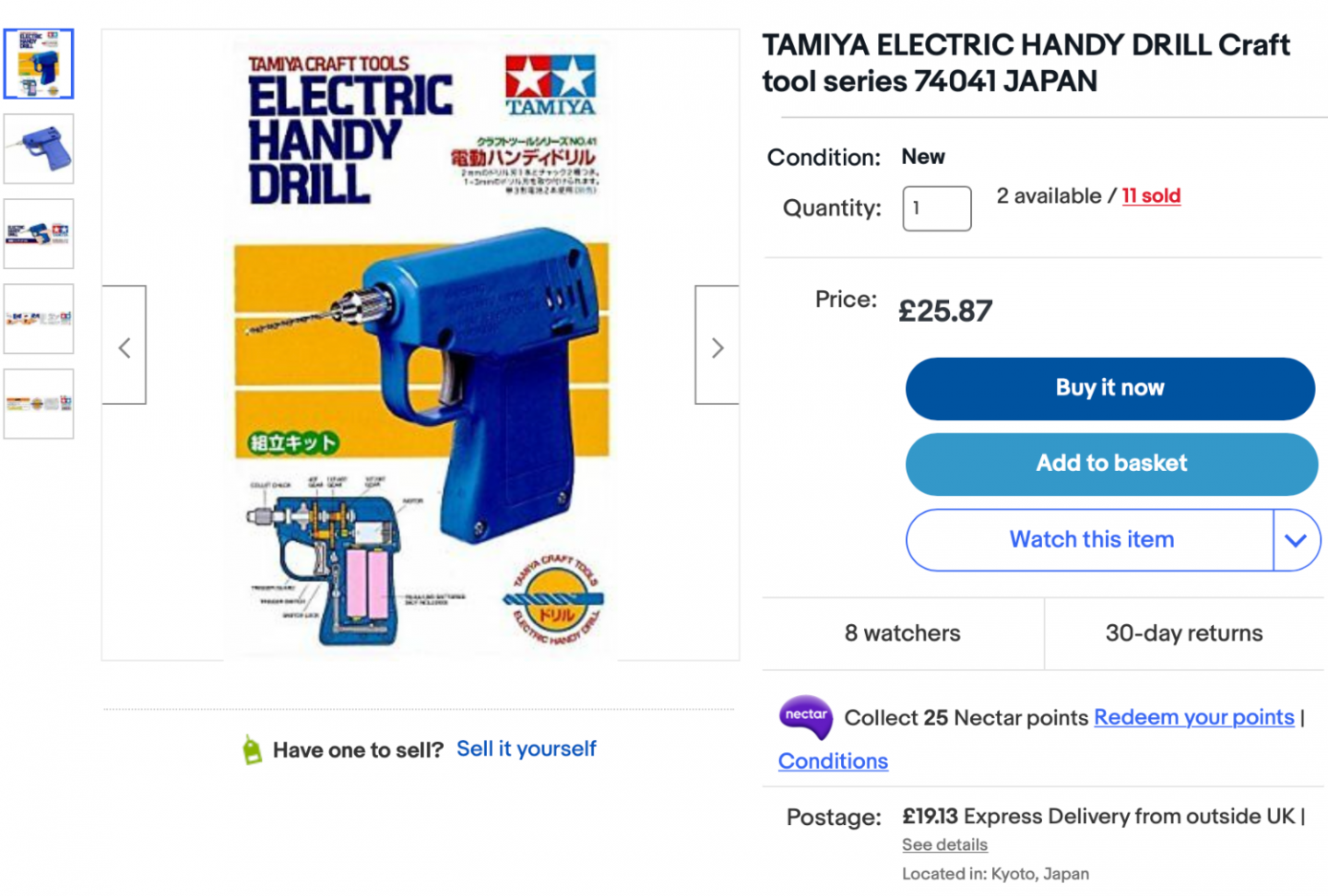-
Posts
3,917 -
Joined
-
Last visited
Content Type
Profiles
Forums
Gallery
Events
Everything posted by KeithAug
-

High torque, really low speed drill
KeithAug replied to Brinkman's topic in Modeling tools and Workshop Equipment
Also rather than a pin vice for drilling small holes you might want to consider one of these. My son bought me the kit as a stocking filler - to some extent as a joke, but surprisingly i find myself using it to drill awkwardly positioned holes where I would normally revert to a pin vice. The speed is very low - probably 400 rpm and the collets only go up to 3mm (.118") so it is a bit limited. A review:- https://doogsmodels.com/2012/07/24/gear-review-tamiya-electric-handy-drill/ -

High torque, really low speed drill
KeithAug replied to Brinkman's topic in Modeling tools and Workshop Equipment
If you want high torque and low speed have you thought about buying a small / cheap electric screwdriver with a chuck mounted in the hex drive. Just a thought🙂. -
Thank you all for your comments. The dinghy sits on a metal frame constructed from .032" and .040" brass sheet. I started with a drawing before cutting off the required widths of brass strip from sheet. The strips in the next photo sit above the sketch. The front and rear frames are of differing shapes to accept the changes of shape in the dinghy hull. The frames are circa 1.3" x 0.8'. The legs are .040" thick and the cross pieces 0.31" thick. The diagonal braces are made from .040" wire. The pieces were cut accurately to length and the "V" was bent to the correct angle. .040" holes were drilled to accept the bracing rods. I made a jig to ensure the soldering of the upright to the base strips was at 90 deg. The jig was just slots in a piece of 1/4" ply with intersections drilled out to give access for soldering. The "V" strip was then soldered in place with the base held against a piece of steel to act as a heat sink. Finally the bracing rods were soldered in place and the supports were then cleaned and polished. Finally the frames were glued and pinned to the deck. The garden is still dominating my time so progress is somewhat limited I am afraid.
-
Eberhard - To my eye it seems to be turning out much more uniform, but i accept you have the advantage of seeing it in the flesh. I'm not sure I would have chosen the foam stuff, wouldn't a soft balsa have worked well?
-
Thank you - I assumed it would be about that length. I was a bit surprised about the length to beam ratio because visually it looks very slender. The hull doesn't look at all bad to me although I can see your perfecionistic tendency getting the better of you.
-
Ah! Basils Bar. Our last Caribbean trip. We spent the afternoon in the bar watching the Germany V Argentina cup final - 13 July 2014. Seems like a long time ago now.
-
I never did get to do the USVI. The BVI's were very nice but we found the sailing a bit limited with all the islands being quite close together. Our preferred sailing grounds in the Caribbean were from Martinique down to Grenada where the wind was invariably easterly force 4 to 5, occasionally 6 (on the beam). The crew and I did this for many years until retirement took its toll on some of the crews finances and it was then back to oilskins and heavy clothing for our final years around the Scottish Isles. Very pretty but usually miserably cold, wet and at times very windy. All now in the past i'm afraid as most of the crew are lacking in fitness and confidence. We do however meet up occasionally for a trip on the Norfolk Broads.
-

Byrnes Saw Mini Sled
KeithAug replied to Roger Pellett's topic in Modeling tools and Workshop Equipment
Ah, now I understand. When I cut thin sheet I tend to stick it to a backing piece of ply to reduce the "chopping" effect caused by the tooth spacing being larger than the sheet thickness. I guess you prevent the chopping by having the blade set quite low and feeding the sheet slowly. -
Eberhard - A good plan but not fool proof. We once had so find the yacht after a thick mist descended but drink made us brave and we were lucky. I too remember all those beach bars and lethal cocktails, even more lethal the day after I recall.
-
Yes many times - usually on route to pub when the motivation was high and then back from the pub when senses were dulled. But i was much younger then!
-

Byrnes Saw Mini Sled
KeithAug replied to Roger Pellett's topic in Modeling tools and Workshop Equipment
Does the prize outweigh the downside of being dead? -

Byrnes Saw Mini Sled
KeithAug replied to Roger Pellett's topic in Modeling tools and Workshop Equipment
Roger The thief's among us would like to see a photo showing the rear side of the angle please. I am wondering how far you went with the saw slot. Also did you consider making the slot as wide as your thickest blade, it looks on the photos as though it is the size of the installed slitting saw? The stop modification will also be of interest. I have a spare 1/2" micrometer body and was considering how this might be incorporated. -
Prop support frames can be very tricky with all those compound angles to negotiate but you pulled it off rather well. The hull plating also looks very good. Well done.
-
Thank you Tom, Veszett, Mike, Hakan, Andy and Gary for all your contributions and as always thank you to all my other visitors. I continued on with the RIB. The rowlocks were made from small bore tube soldered to a strip of brass. The middle of the tube was then removed. The seat was also made - pinned into the the sides with bent brass wire. I then started to make the oars from brass rod, brass tube and thin brass sheet. Here the blade is inserted into a slot in the .040" brass rod thickened with brass tube. Also the rod is thickened at the rowlock to take the rowlock shaft. Braces that strengthen the transome were also attached. The blades were soldered in and the rowlocks were attached. The handles were made from heat shrink tube. The oars are stowed along the RIB sides as per the next image. Clips that support the blade end of the oars were made and attached. They were made from tube attached to brass strip as per the rowlocks. The top of the tube was then filed away to form the open jaw. The fabric of the inflatables is reinforced in high load and high wear areas. I started to attach fabric tape to simulate these areas.
-
I think it is a common symptom of exposure to this forum and is more severe among micro modellers. I prescribe a good bottle of wine and a night off. Was it quilted or just the standard stuff 😀. Nice little boat. What is its actual length and beam?
-
Yes - I saw a very good video (with survivor interviews) several years ago. If my recollection serves me well (which isn't always the case) she could have arrived early but choose to delay entry to "arrive on time". Am I fantasising???
- 454 replies
-
- Union Steamship Company
- Stepcraft 840
-
(and 3 more)
Tagged with:
-
Lou You are walking a tight rope. Scotch is indeed a drink and Scot is a person. They get very touchy about the distinction north of the boarder. On the other hand you may indeed have a lot of scotch in your ancestry - I remember all of those western bar scenes.
- 454 replies
-
- Union Steamship Company
- Stepcraft 840
-
(and 3 more)
Tagged with:
-
Nils - Maybe she deserves a new one😀 With 6 sails I suspect she will look magnificent.
- 180 replies
-
- pilot boat
- Elbe 5
-
(and 3 more)
Tagged with:
-
She is coming along really well Nils. Are you planning to model the full set of sails?
- 180 replies
-
- pilot boat
- Elbe 5
-
(and 3 more)
Tagged with:
-
Eye watering - I think I would be considering dry sand sealed in heavy duty plastic bags - but then again I'm a bit of a Scrooge.
- 454 replies
-
- Union Steamship Company
- Stepcraft 840
-
(and 3 more)
Tagged with:
About us
Modelshipworld - Advancing Ship Modeling through Research
SSL Secured
Your security is important for us so this Website is SSL-Secured
NRG Mailing Address
Nautical Research Guild
237 South Lincoln Street
Westmont IL, 60559-1917
Model Ship World ® and the MSW logo are Registered Trademarks, and belong to the Nautical Research Guild (United States Patent and Trademark Office: No. 6,929,264 & No. 6,929,274, registered Dec. 20, 2022)
Helpful Links
About the NRG
If you enjoy building ship models that are historically accurate as well as beautiful, then The Nautical Research Guild (NRG) is just right for you.
The Guild is a non-profit educational organization whose mission is to “Advance Ship Modeling Through Research”. We provide support to our members in their efforts to raise the quality of their model ships.
The Nautical Research Guild has published our world-renowned quarterly magazine, The Nautical Research Journal, since 1955. The pages of the Journal are full of articles by accomplished ship modelers who show you how they create those exquisite details on their models, and by maritime historians who show you the correct details to build. The Journal is available in both print and digital editions. Go to the NRG web site (www.thenrg.org) to download a complimentary digital copy of the Journal. The NRG also publishes plan sets, books and compilations of back issues of the Journal and the former Ships in Scale and Model Ship Builder magazines.





